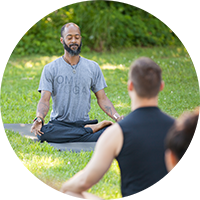The Ultimate Guide for Community Yoga Classes
By: Susan Lovett, one of the winners of Yoga Alliance's International Day of Yoga Grant
Published: July 14, 2016






Sometimes teachers don’t have the luxury of leading classes in spaces that have been intentionally designed for yoga. In community-based yoga settings, there are no pristine bamboo floors, deluxe sound systems or walls of blankets, blocks and straps. Community-based classes often take place in meeting rooms, classrooms and shared programming spaces. We can’t control much about the space, so we acknowledge that we have to do what we can to soften the setting and flow on.
By teaching community yoga classes, we get to spend time with people who may not have crossed our paths or even tried yoga otherwise. The time together in these spaces, heart to heart, is a profound experience for both yoga teachers and their students.
What to Expect
To successfully teach in non-yoga studio settings, it’s important that yoga teachers appreciate imperfection and unpredictability. Remaining open-minded and flexible go a long way toward creating effective yoga classes. By balancing that with routines and consistency, our students feel safe and know what to expect from each class. Further, teaching community yoga classes often means doing more than just yoga; at Hands to Heart Center, our yoga teachers often get warmed up before their classes even begin by moving furniture and sweeping floors.
As an organization that facilitates these community classes, our goal is to make it easy for our volunteers to show up and teach. We’ve found that providing teachers with a Class Information Form is very helpful for teachers to know what to expect when they get to the space. The Class Information Form contains all of the details of the yoga class request – location, parking/public transportation information, description of room, number of students, general description of student population, type of class requested, on-site contact person and their phone number.
What to Bring
To provide the highest quality experience for students, preparation and organization are critical. Hands to Heart Center takes the “pop-up” approach by attempting to transform the locations of our yoga classes into calming environments. We deliver yoga mats and “Class Kits” to teachers prior to the start of our community-based classes. These kits contain student release forms and guidelines for the staff of our community partners/hosts to follow.
The guidelines detail specific ways that staff can support the classes – the first: ask them to participate! It’s also important to let staff know that participation in our classes is completely optional and that throughout class, students are welcome to do as much or as little of the practice as they choose. We’ve also learned to explicitly inform program staff that they need to observe silence during savasana. Being direct about these expectations and encouraging partner staff to share any questions or concerns with our teachers has resulted in more successful yoga classes and stronger relationships between our teachers and community partners. Our yoga teachers really appreciate not having to “shush” any staff who may be talking during the final resting pose and the staff love knowing that savasana is for them, too.
Our Class Kits also contain LED candles (students love these!), essential oils, scented room spray, eye pillows, physical contact option cards, mat cleaner, cloths and a teacher notebook for notes, reminders, follow up questions, etc. The oils and eye pillows often draw initially reluctant participants onto a yoga mat. Many of Hands to Heart Center’s classes take place in detention units, shelters and residential treatment programs so we make every effort to add sweetness by offering of a few drops of scented oil on students’ wrists. Soft instrumental music can be very soothing for students to enjoy during class too.
Perhaps the most essential tool in our Class Kits is the physical contact option cards. Teachers can simply use index cards and write “yes, please – I’m open to physical contact” or “no thank you – I’d prefer not to receive physical contact” and distribute the cards to all students at the start of class with an explanation. (We recommend doing this in regular yoga studio classes, too – your students will thank you!) Let students know they can flip their cards throughout class depending upon how they feel. No matter which option they choose, be sure to respect their choice.
How to Prepare
For yoga teachers who are interested in teaching in community settings, we recommend scheduling a visit to the location prior to their first class. If possible, meeting with the staff and program participants to introduce yourself and answer any questions about yoga/your class is also a great idea. This “pre-class” visit can alleviate some of the anxiety first-time yoga students may be feeling and can begin the process of relationship building. Offering some chair yoga while you’re there is a great way for people to experience a brief practice for themselves.
The most important part of teaching in community settings (and in yoga studios) is for teachers to really see the students in the class. See how they’re feeling, how they’re moving, what they want, and what they don’t want. Be genuinely interested in who they are and how they’re showing up. Breathing, moving and learning with others in a safe, supportive space while feeling included and supported can be transformative for all students – and their teachers.
About Susan

Susan Lovett is a licensed social worker, certified K-8 teacher and yoga teacher who has been working with low-income urban youth and families for 25 years. She is also the director of Hands to Heart Center – Yoga for the People, a nonprofit yoga service and action organization that provides free yoga classes for people living with poverty and trauma in Boston. They connect yoga teachers with opportunities to volunteer in low-income communities. Since Hands to Heart Center was founded in April 2014, they’ve taught over 700 free yoga classes in branch libraries, community centers, detention units, domestic violence shelters, high-poverty schools, homeless shelters, public housing developments and residential treatment programs.